ICCIA - Exotic guest from tropical countries. It will make paintness and unusualness even in the most ordinary and unpretentious garden. This flower is only gaining momentum for growing in areas. Recently, it becomes fashionable to grow decorative plants of similar bright and unusual colors. Iccia will like fans of fragrant colors, as well as birds in the garden. In this article, you will learn everything about ICSIA, growing and leaving this plant, we will highlight the distinctive features of the species and varieties of ICSI.
ICCIA. Plant Description
- Iccia is a perennial plant with a root system in the form of a bulb.
- Iccia belongs to the Iris family.
- Motherland of ICSI are countries of South Africa.
- Ixia began to be actively grown in decorative purposes since 1770.
- The reason for this name of the plant is considered to be attributed to the word "ixios", which means "bird glue". Bird glue is a sticky composition for catching birds or insects. Ixia just has a pretty sticky nectar attracting insects.
- Iccia is capable of reaching 50-70 cm in height. Of course, it depends on the varieties and conditions for growth and development.
- Iccia has a very subtle and elegant stem, which has accommodated inflorescences.
- Flowers of Iqualies can be of a variety of colors and shades. This feature is largely attracted by gardeners who want to add paints to their site.
- Flowers of Iccons exude a thin and gentle fragrance, which attracts not only people, but also bees.
- The thin stem of ICCIA "decorated" with a small amount of sword-shaped leaves, which grow straight from the bulbs.
- Iccia is a summer flower. The phase of active flowering occurs in the late spring or early summer. It will be rejoiced to Pöstrian paints for a short time - about 1 month. Flowers immediately attract attention to the richness of juicy colors.
- In the dark time, the delicate flowers of ICSI "hide". With the sunrise, they reveal their petals again.
- About 25 types of ICSIA are known, each of which is represented by a large number of varieties. The most fortunched are hybrid varieties of ions.
- ICCIA - Southern plant from the tropics. She loves the sun and water. For beginner gardeners, growing this plant may seem difficult due to its capriciousness to growth conditions.
- The bright flowers of ICSIs in the form of small stars look spectacularly both in independent landings and in aggregate with other decorative plants. Gardeners are singing in the mountaineering, group flower beds, near the tracks, etc.
ICCIA. Varieties
Experienced gardeners know that to create the most spectacular flower arrangements, it is better to grow several varieties of ICSIs at the same time. Decide which color you lack, and choose the appropriate variety. At the moment, about 20 species and a large number of varieties are known. Hybrid varieties are most popular.
Iccia Himenokallis
Ixia Himenokalles immediately attracts its unique form of flowers. They differ from the usual shape of the colors of ICSI, which resemble small stars. This variety of ICSI has long-speaking petals that make a flower like a sunshine. Very often, Himenokalle's ICSI is compared with daffodils. The flower flashes in the late spring or early summer. Coloros reach a height of 70 cm. Iccia can have a white-white or light-purple flowers. Thin fragrance attracts a large amount of butterflies and bees. This type of ICSI will become an excellent exotic decoration of your garden.
ICICSIA ZELENENKOVKAYA
IKSIA ZELENENKOVY - Pretty rare plant. But if you manage to find seeds of a similar variety, then be sure to try to grow this beautiful plant. Gardeners attracts an interesting and unusual combination of colors. Absolutely black middle of the flower is surrounded by gentle petals of the emerald shade. Inflorescences, like most of the varieties of ICSI, accosate. The flowering period occurs at the beginning of summer. Such a plant will definitely become a "highlight" of the flower beds on the site.
IKSIA spotted
Iccia spotted is also not inferior to the exotic appearance to its "counterparts". Dark middle flower is surrounded by spotted petals. Petals have a simple, smooth, rounded shape. Also, the stem in ICSI spotted is framed by green narrow leaves. The plant grows up to 45-50 cm. Iccia spotted always cares looks at her eyes and conquers a gentle aroma.
Hybrid Iccia
Hybrid Iccia is a form that combines many hybrid varieties. Most of these varieties enjoy incredible popularity among gardeners. You will be surprised by the manifold of paints and shades that you can give hybrid izksi. Especially spectacular will grow of several varieties of hybrid oscillations. The undoubted advantage of hybrid varieties of ICSI is the smaller "capriciousness", the large stability of plants to adverse environmental conditions. The most famous varieties are:
- Blue Bird;
- Rose Emperor;
- Giant;
- Early Surprise;
- Castor;
- Vulcan;
- Hollands Glory;
- Yellow Emperor.
Iccia Orange
Another beautiful decoration of your garden can be an orange oscillation. The plant can be attributed to the dwarf, because Its height rarely exceeds 20 cm. Low growth is successfully compensated by plentiful and active blossoms. Bright orange flowers with brown-red middle, look particularly impressive in combination with green leaves.
Ixia paniculata
Icycous Miscellaneous will become one of the most graceful and sophisticated plants on your site. It reaches a height of 40 cm. Flowers in this species of oscillation of snow-white with a red core. Enjoy a great love among the gardeners.
ICCIA. Photo
ICCIA. Growing in the open soil
Step 1. When to plant qc
- Iccia is a thermo-loving plant. In countries with the harsh winters, the bulbs are necessarily digging to prevent their death. The tubers are thoroughly washed in a manganese solution and stored in a dry room at a temperature of about 10 degrees of heat. In such countries, the landing of ICSI produces in spring, approximately in May.
- If Iczese is grown in southern countries with soft climatic conditions in winter, then you can plant this plant as in the spring and in the winter. The landing site of ICSIA before the winter should be covered with a good mulching layer, and in the spring to remove it.
As you can see, the landing time of ICSIA directly depends on the climatic zone and the specific temperature during this period of time. After all, the beginning of May this year should not necessarily be the same warm, as last year. Focus on long-term weather forecasts in their location.
Step 2. Select a place to land ICSI
The main criterion for choosing the right place to land ICSI is good illumination. With a lack of sunlight, the flowers of izxi may heat, lose the brightness of the paints. Pristore and "neighbors" for ICSIA. It is advisable to avoid high trees that will constantly create a shadow. Iccia prefers to grow in a windless and sunny place alone or next to other low-spirited plants.
Step 3. What the soil loves ICSIA
Tropical plant Iccia prefers to grow on lungs and air soils with good drainage. Stagnation of water is extremely undesirable, as for all bulbous ornamental plants. Before boarding the ICSI, on the site well prepare the soil:
- the soil should be loose and well reheated;
- make manure or humus (1 bucket per 1 sq. M);
- also enter into the soil 60-70 Gy of superphosphate, 300 grams of wood ash and 25 grams of magnesium;
- soil should not be "heavy." You can make some river sand to make the soil more loose and light.
Step 3. ICCIA. Landing
If you have already chosen a landing place and prepared the soil, then it remains very little:
- drop the wells with a depth of about 5-8 cm;
- on the bottom of each well, you can pour a little finished nutritional mixture;
- the minimum distance between children of bulbs is about 8 cm, and between the tuberukov, about 20 cm;
- the bulbs before landing should be carefully examined. Any damage, "wounds" need to sprinkle wood ash, treat the bulb of the fungicide;
- push up the bulbs of the earth and inspire the landing site;
- a very important landing rule of ICSI is that this plant does not need to wipe immediately after landing;
- after 2-3 weeks, ICSI searches should appear;
- the first watering with warm water should take place just with the advent of the first germs.
Remember also that if the planting material was separated by the tubers, then Ixia would not bloom at once for the first year. It will happen on the 2nd or 3rd years of landing.
ICCIA. Care
African beauty Ixia in planting and care is rather capric. This is not the plant that you planted and forgot about it. To enjoy the maximum lush and bright flowering of ICSI, follow the following rules for the care of it:
- the first irrigation of ICSI should take place when the first searches will appear. Water for watering use room temperature or even slightly warm;
- during the tying of buds and during flowering, watering is especially important for ICSI. The earth must constantly be wet. You can not allow it to dry. Even short-term disadvantage in moisture can destructively affect the quality of flowering;
- providing a good watering plant, do not forget that the bulbous plants will not tolend the stagnation of water. The bulbs can start grew. To prevent this and need a good drainage layer;
- after the flowers of Ixsies dried, the watering cease;
- listen to dried flowers on time. They will only spoil the appearance of the plant;
- mulse the surface of the earth around the plant after each watering. So you will most save moisture for the plant;
- iccia, like any decorative plant on the flower bed, is positively responding to feeding. The introduction of various mineral and organic fertilizers will only increase the puff of flowering and will extend this period as much as possible. Special stores for gardeners have a huge range of finished fertilizers for bulbous plants. Carefully read the instructions and do not exceed the dose;
- after Ixia dried, you need to dig it on the bulbs and provide them with comfortable storage conditions until the next spring. In the southern regions with mild climatic conditions, such a need disappears. The bulbs are perfectly winter in the ground. Previously need to be inspired from above the good layer of mulch.
You can try to grow exotic icy and in the apartment. But then the care will be significantly more time-consuming. First, you need to purchase a special lamp, which will provide lighting within 16-17 hours. Secondly, you need to create special temperature conditions. The room should be about 10 degrees of heat. As you can see, organize such conditions in the residential room will be quite problematic. An ideal place can be a winter garden, a greenhouse, a loggia.
ICCIA. Bulbs and their storage until spring
Each dacket that has successfully coped with the cultivation of African beauty of ICSI, I want to repeat this next season. It's easy enough to do it. Moreover, now you have a valuable landing experience and care for Icia. Take into account the following recommendations for the storage of ICSIA Lukovits in winter:
- digging the bulbs after the entire aboveground part of the plant has already completed its development cycle and growth;
- the bulbs need to be carefully cleaned from the ground and dry;
- the bulbs are then soaked in a mortgage solution for disinfection;
- after that, the bulbs again need to dry;
- watch the tubers in paper, the sheets of the newspaper and store in the refrigerator on the bottom of the shelf until the next spring.
Some gardeners mistakenly believe that if dug bulbs put in a pot into the ground, then they will be preserved better. But it is not. Of course, in the soil, ICSI will feel excellent, but it will go into growth and to the arrival of spring will lose their vitality. Growth and flowering will not be so intense, whatever could be.
ICCIA. Reproduction
The reproduction of ICSI seeds
The seed method of reproduction of ICSIA is considered one of the most unpopular. Plants planted in this way will bloom only for the third year after landing. The seed method of breeding ICSIA is most often selection of breeders in the elimination of new hybrid varieties. Small seeds of ions for convenience are mixed with sand and evinted into containers. After 2-3 weeks, the first searches should appear. After the bulbs are tuned, we can transplant plants into open ground.
Reproduction of ICCIA root process
If Iczese grows on your site already 3rd or 4th year, then its bulb can already grow with kids. You will immediately notice them as soon as you dig root. New processes need to be separated and placed in pots with a mixture of sand and peat. Planting plants multiplied in this way, can start on the 2nd year.
Reproduction of ICSI on bulbs
The reproduction of ICSIA by dividing the bulbs is one of the most popular ways. Plants can start blossoming in the first year after landing. The bulb division procedure is produced in spring, immediately before landing. The bulb should be cut in such a way that each of the parts have "peephole" and part of the root. The location of the cut must be sprinkled with ashes or green. To prevent rotting processes.
ICCIA. Dangerous diseases and pests
To the great joy of novice gardeners, Iccia is well resistant to diseases and pests. This is a certain plus for a capricious African beauty. The only thing you may have to face with the cultivation of ICSIA, this is the defeat of the bulb. How to suspect this ailment? It is possible to determine the beginning of the decay of the bulbs in the following symptoms:
- the yellowing of the blooming;
- the disappearance of buds;
- sharp deterioration of the appearance of the flower;
- loss of elasticity of the plant.
Noticing these symptoms, you can try to cut watering. If ICCIA will quickly recover, then you have managed on time. If the appearance of the plant does not improve anywhere, then you need to dig a bulb. Perhaps the processes of rotting are so intensified that it will have to be thrown away.
ICCIA. Usage in landscape design
Iccia is an exotic and charming flower, which will be perfectly looking at almost anywhere on the plot. Someone considers the cultivation of ICSIA troublesome business, and for someone any concerns behind the flower only bring joy. It all depends on your desire and opportunities. Iccia will be superbly looking at the following places on the plot:
- rocky rocarium;
- flowerbed;
- alpine slide;
- containers;
- vases.
A huge color variety of flowers of ICSIs make it possible to successfully combine it with a variety of decorative plants. Gardeners combine this African beauty with such plants as:
- gladiolus;
- freesia;
- petunia;
- lobelia;
- fASHENA;
- kotovnik;
- linen;
- miscantus;
- waik.
When creating a flower, consider the basic rules of the combination of colors. Speeciously look at both completely contrasting plants, and close to shades. Mixed varieties of izksi are popular with popularity, which will create real fireworks for you. Exotic ICSIA will be perfectly looked and just on the lawn. Simple forms of its flowers will create a natural charm of nature. Experienced gardeners are very often cunning adoption when landing neighbors for ICSIA. These must be plants that are the same with it for growth. Thin stems of ICSI will be "relying" on these plants and maintained.
Ixxies are very often grown and for decoration of beds in the garden. Fragrant flowers are suitable for cutting bouquets. Cut the flowers for a bouquet when the buds are not completely blossomed. Such an amazing bouquet will simply have about 3 weeks in the water.
Do not be afraid to try your strength in the cultivation of this African stranger. ICSI planting and care in the open ground is complicated only in theory. Inspired by her lush flowering, you will not be able to forget it. Successes!

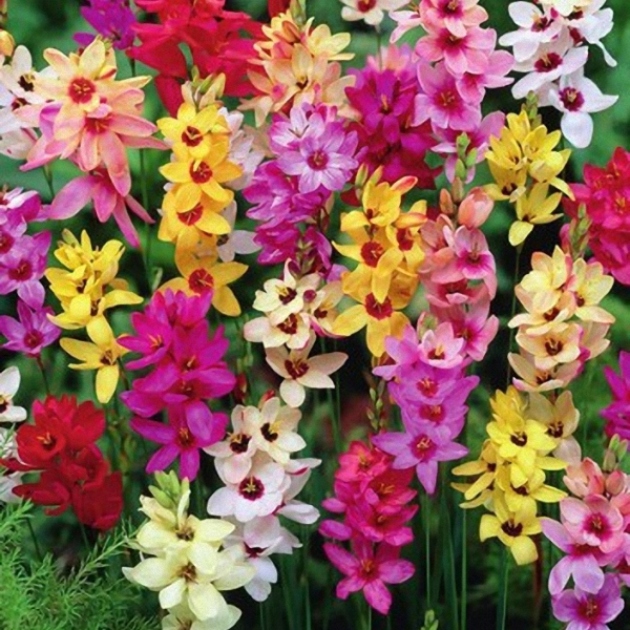
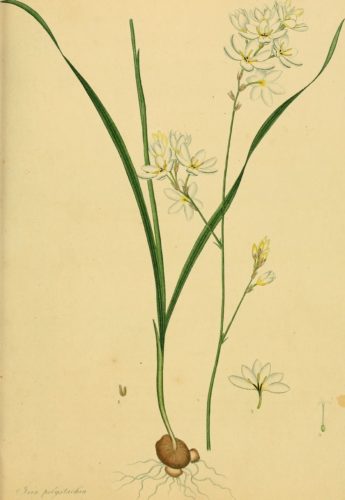
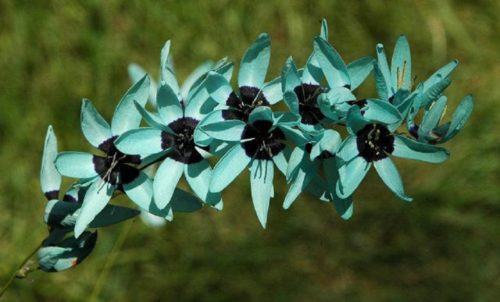
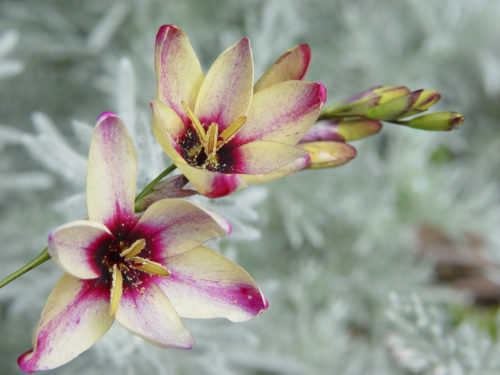
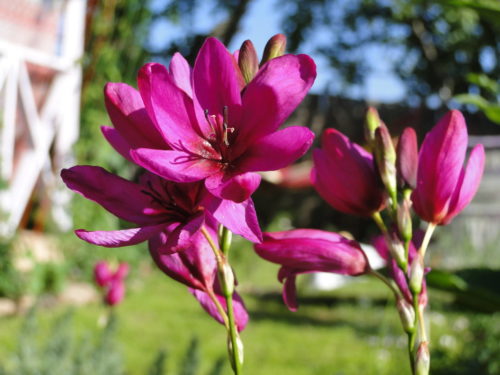
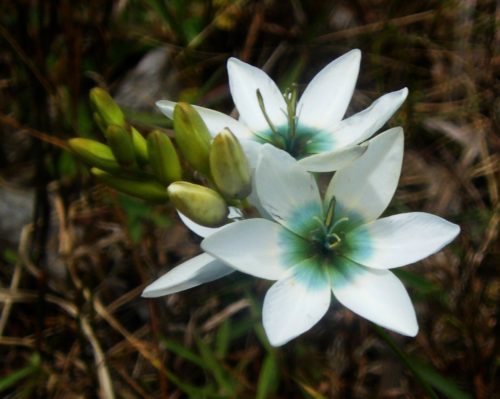
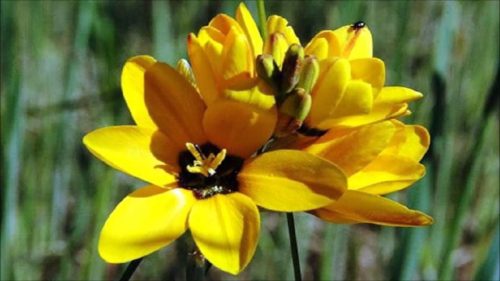

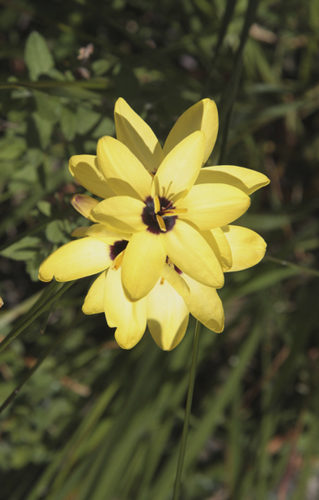
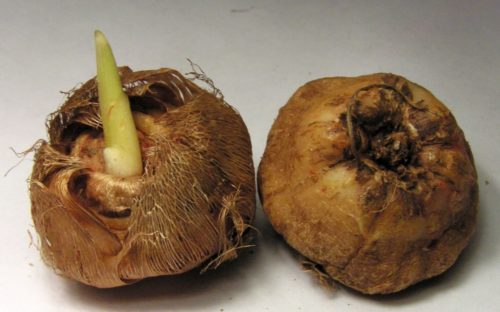

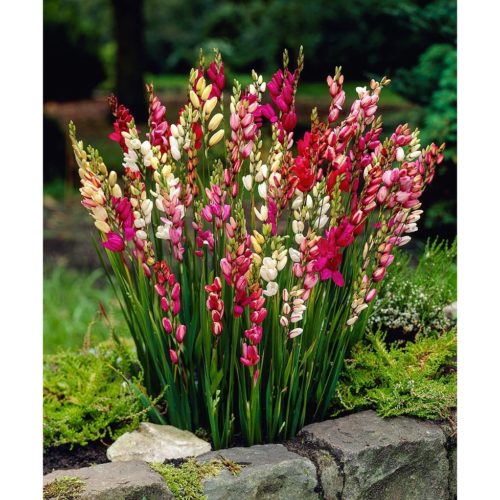
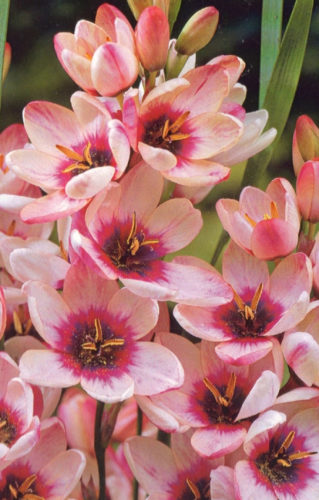












 Start a discussion ...
Start a discussion ...